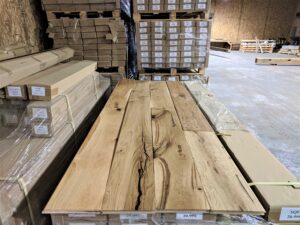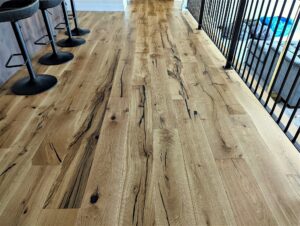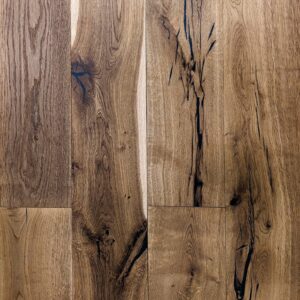What are Tannins in Wood & Why It’s Key for Oak Flooring?
Posted: May 12, 2025Author – Ryan Palma Owner/CEO Sustainable Lumber Co.
Click on the link to view our 3 colors of Rustic White Oak flooring, or to contact us for a pricing quote.
What are Tannins in Wood and Why Does It Matter?
 Oak is a preferred choice for hardwood flooring in residential and commercial spaces due to its durability, aesthetic appeal, and versatility. A key factor contributing to oak’s performance is its high tannin content, a naturally occurring compound that enhances the wood’s properties. This post explores what tannins are, how they benefit oak, and why they make oak an excellent material for flooring applications.
Oak is a preferred choice for hardwood flooring in residential and commercial spaces due to its durability, aesthetic appeal, and versatility. A key factor contributing to oak’s performance is its high tannin content, a naturally occurring compound that enhances the wood’s properties. This post explores what tannins are, how they benefit oak, and why they make oak an excellent material for flooring applications.
Understanding Wood Tannins and Their Role in Oak
Wood tannins are polyphenolic compounds present in the bark, leaves, and heartwood of various tree species, including oak, chestnut, cedar, and redwood. In trees, tannins serve as a natural defense mechanism, protecting against fungal growth, bacterial infection, and insect damage. In oak, tannins are particularly concentrated in the heartwood, the dense core of the tree used in flooring production. These compounds influence the wood’s color, durability, and interaction with environmental factors, making them a critical component in oak’s suitability for flooring.
The Benefits of Wood Tannins in Oak Flooring

- Enhanced Durability
Tannins act as a natural preservative, increasing oak’s resistance to decay, fungi, and insect damage. This durability is particularly valuable in flooring, which is exposed to foot traffic, humidity, and occasional spills. White oak, with its higher tannin content and denser grain, offers superior moisture resistance, making it suitable for areas like kitchens or bathrooms. Red oak also benefits from tannins, providing reliable performance in high-traffic spaces. - Aesthetic Qualities
Tannins contribute to oak’s distinctive coloration, ranging from light golden tones to deeper reddish-brown hues, particularly in red oak. These colors develop a natural patina over time, enhancing the floor’s visual appeal. Oak’s prominent grain patterns complement its tonal qualities, allowing it to suit a range of design styles, from traditional to contemporary. Tannins also enable oak to accept stains and finishes evenly, providing flexibility for customized flooring aesthetics. As a result, wood tannins not only contribute to protection but also help bring out oak’s natural charm in both rustic and modern designs. - Structural Strength
Oak is a hard, dense wood, with white oak rating approximately 1,200 on the Janka hardness scale and red oak at around 1,150. This strength enables oak flooring to withstand heavy use without significant denting or scratching. Tannins reinforce this durability by protecting the wood from biological degradation, ensuring long-term performance in demanding environments. - Dimensional Stability
Oak’s tight grain structure and moderate dimensional stability minimize warping or cupping due to changes in humidity. Tannins further enhance this stability by reducing the wood’s susceptibility to moisture-related decay, making oak a reliable choice for consistent performance across seasons. - Compatibility with Finishes
The presence of tannins allows oak to absorb stains and sealants uniformly, facilitating a consistent finish. However, tannins can react with iron, potentially causing dark discoloration if iron-based fasteners or objects are used. To prevent this, stainless steel hardware is recommended during installation. - Cost-Effectiveness and Availability
Oak is widely available in North America, making it more affordable than exotic hardwoods such as teak or mahogany. Its tannin-driven durability reduces maintenance and replacement costs, offering long-term value for flooring projects.
Why Oak with Wood Tannins Excels as a Flooring Material
Tannins are a significant factor in oak’s suitability for flooring, but they work in tandem with the wood’s other attributes. White oak is often selected for moisture-prone environments due to its enhanced water resistance, attributed to its tannin content and tighter grain. Red oak, with its slightly more pronounced grain and warmer tones, is favored for spaces where aesthetic impact is a priority. Both varieties benefit from tannins’ protective qualities, ensuring durability and visual appeal over time.
Oak Flooring Best Practices & Care Tips
To maximize the benefits of oak’s tannin content and natural properties, consider the following recommendations:
- Apply a High-Quality Sealant: A properly applied sealant protects tannins from excessive moisture exposure and preserves the wood’s finish.
- Use Appropriate Cleaning Methods: Clean oak floors with mild, wood-safe products to maintain their integrity and avoid damaging the tannin-enhanced surface.
- Select the Right Variety: Choose white oak for areas with higher moisture levels and red oak for spaces prioritizing visual warmth and character.
Conclusion: Why Tannins Matter in Oak Hardwood Flooring
Oak’s high tannin content is a key reason for its widespread use in hardwood flooring. Tannins enhance durability, contribute to rich coloration, and support oak’s ability to withstand environmental challenges, making it a practical and attractive option for diverse applications. Combined with oak’s strength, stability, and affordability, these qualities ensure that oak flooring remains a trusted choice for creating lasting, beautiful spaces.
Contact Us
Our knowledgeable and educated staff is here to answer any additional questions you may have. Please call us today for a free quote: Ph# 406.642.7120 or click here to submit an inquiry online. We look forward to working with you on your next project!


